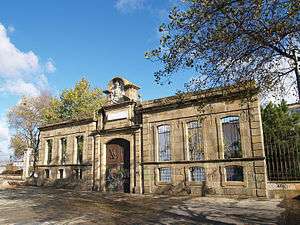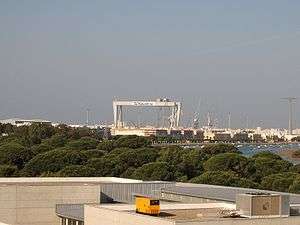Navantia
|
| |
| State-owned enterprise | |
| Industry | Defence, Shipbuilding, Engineering |
| Predecessor | Empresa Nacional Bazán |
| Founded | January 1, 2005 |
| Headquarters | Madrid, Community of Madrid, Spain |
Area served | Worldwide |
Key people | Esteban García Vilasánchez (Chairman and President) |
| Products | Warships, Hospital ship, Yachts, Ferries, Cargo ships, Platform supply vessels, Dredger, Marine propulsion, Offshore engineering |
| Revenue |
|
|
| |
|
| |
| Owner | SEPI (100%) |
Number of employees | 5,500 (2015) |
| Website | www.navantia.es |
Navantia is a Spanish state-owned shipbuilding company, which offers its services to both military and civil sector. It is the fifth largest shipbuilder in Europe, and the ninth largest in the world with shipyards all over Spain.
Astilleros Españoles SA had been created in 1967 by merging the Basque shipyards of Euskalduna, La Naval de Sestao and Astilleros de Cádiz. In July 2000 it merged with the public naval shipyards, Empresa Nacional Bazán, to form IZAR.[1] In March 2005 Sociedad Estatal de Participaciones Industriales (SEPI) fusioned the naval wing of IZAR into Navantia.
Company
_01.jpg)

Navantia, the Spanish shipbuilder, 100% owned by SEPI, the Spanish Government Industrial Holding, is engaged in the design, construction and integration of warships, as well as ship repairs & modernizations. It is also engaged in the design and manufacture of Integrated Platform Management Systems, Fire Control Systems, Command and Control systems, Propulsion Plants and through life support for all its products. Even though its main line of activity is in the naval field, Navantia designs and manufactures systems for the Army and the Air Force.
Navantia has a shiprepair line of activity that goes from regular repairs to refurnishment programmes, including conversions. The company has the facilities and know how for complex repairs comprising LNG’S and Cruisers. Navantia has Fleet Maintenance Agreements with ship-owners. It also has an important presence in the development of new technologies in the off-shore Oil and Gas and wind energy markets.
Navantia has experience in building technologically advanced ships like frigates, amphibious ships, patrol vessels, and submarines. In the last years, it has supplied ships for different navies, like Norway, Australia, Chile, Spain, India, Thailand, Venezuela. It has also been selected in Turkey as the designer for the LPD program.
Navantia is a reference in surface warships, having been able to integrate the AEGIS LM system in a much smaller platform. It has designed and built the F-100 Alvaro de Bazán class frigates (5 units) for the Spanish Navy and the F-310 Fridtjof Nansen class (5 units) in service at the Royal Norwegian Navy. The Australian Warfare Destroyer, currently under construction, is another Navantia design also based in Navantia F-100 frigate. At present the challenge is the F-110, the future Spanish Frigate that will have to perform new capacities and missions in a changing and challenging international scenario.
The F-310 class frigates are one of the programmes the company has executed. They have already participated in various international missions: F310 in Seasquad, USA (2007), F310 in Somalia (2009), F311 exercised with the US Navy in 2008, F313 and F310 exercised with NATO in 2010.
In September 2007, Navantia won the contract, as the main partner, for two amphibious ships for the Royal Australian Navy very similar to the LHD “Juan Carlos I” that Navantia has built for the Spanish Navy.
The Spanish offer for the design and construction of these ships, based on the Spanish LHD, was selected because it completely met the requirements of the Royal Australian Navy. The contract included the design and construction of the ships, as well as some equipment, e.g. engines and electronic platform control systems, provided by Navantia.
In March 2016 Navantia was selected as the "preferred bidder" to build two logistics support ships for the Royal Australian Navy.[2]
Major projects

- Carriers
- Príncipe de Asturias Harrier carrier (commissioned 1988)
- HTMS Chakri Naruebet (1997)
- Amphibious ships
- Juan Carlos I Landing Helicopter Dock (2010)
- Canberra-class LHD (2014)
- Galicia class LPDs (1998,2000)
- LCM-1E landing craft
- Supply ships
- Aegis Combat System | AEGIS Frigates
- F-100 Álvaro de Bazán class frigate (2002–12)
- F-310 Fridtjof Nansen class (2006–11)
- Hobart class destroyer (2016–19)
- Corvettes
- AEGIS Corvette
- Multirole Corvette
- Patrol Ships
- BAM ocean patrol vessels (Spain, 2011–12)
- Guaiquerí-class patrol boat (Venezuela, 2011–12)
- Guaicamacuto-class patrol boat (Venezuela, 2010–11)
- Attack Patrol Ships (44 m, 47 m, 63 m)
- Oceanic & Coast Patrol Ships (79 m, 99 m)
- Mantilla-class patrol vessel (Argentina, 1982-3)
- Submarines
- Scorpène class submarine - joint venture with DCNS for export
- Isaac Peral-class submarines (S-80A)
- Minehunter Ships
- Oceanographic Ships
- Combat and Control Systems
- Propulsion and energy generation systems
- Ship repair and conversions
See also
References
- ↑ ASTILLEROS ESPAÑOLES. 1969-2000
- ↑ "Pre-election promise on shipbuilding sought by Labor, Xenophon, unions after Spain wins naval deal". ABC News. 11 March 2016. Retrieved 13 March 2016.
External links
| Wikimedia Commons has media related to Navantia. |
